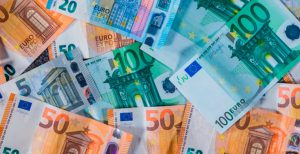Bloomberg
Even the prospect of an historic rate hike isn’t enough to bolster the euro, which is feeling the weight of risks from the region’s uneven economic recovery and the war in Ukraine.
The common currency shrugged off the European Central Bank’s (ECB) most hawkish messaging in more than a decade and its planned reversal from an era of negative borrowing costs. While traders ramped up bets on the rate hikes seen this year, the euro extended its fall on Friday, breaking below $1.06 for the first time in nearly three weeks.
While President Christine Lagarde dangled the possibility of an even larger hike in September — after policy makers committed to a quarter-point rate increase next month — she also cited “significant downside risk to growth†from the war.
In addition, traders were left unconvinced by her plan to shield weaker euro-area nations from rising borrowing costs, as evidenced by a widening in Italian bond spreads by the most since the early months of the pandemic.
Investors might start to factor in the mounting risks for Europe’s growth outlook, “which could limit the degree to which the ECB can deliver the amount of tightening priced by the market†through the end of the year, according to Dominic Bunning, head of European currency research at HSBC Holdings Plc.
The euro is down more than 6% versus the dollar this year, adding to a nearly 7% slump last year. A 25 basis-point ECB hike in July would be its first since 2011, though it compares with 75 basis points of tightening from the Fed so far this year.
While ING Groep strategists including Francesco Pesole say the euro is likely to decline to $1.05, arguing ECB hawkishness is insufficient for a boost, Principal Global Investors Chief Strategist Seema Shah argued it may be time for the currency to shine.
The narrative of a stronger dollar is being challenged “with peak Fed expectations now likely behind us and ECB rate expectations rapidly moving higher,†said Shah. “A rally in the euro is in sight.â€
Yet investors are skeptical the ECB can match hawkish expectations in the rates market, which has already priced in 140 basis points of tightening by year-end.
One reason is that such a pace of tightening would especially hurt countries like Italy, among euro-area nations with the biggest debt burdens.
“Periphery concerns also constrain the ECB and limit euro strength,†according to Bank of America Corp. analyst Athanasios Vamvakidis.
The spread between yields on Italy’s 10-year bonds over their German peers — a key gauge of debt risk in the region — soared above 225 basis points on Friday, the widest since May 2020.
Market pricing also implies that with only four meetings left this year, the central bank would have to hike by a half-point in at least two of them. That seems unlikely, according to Mazen Issa, a strategist for TD Bank.
He sent a note to clients after the ECB rate decision with a blunt subject line: “Sell EURUSD.†It’s a sentiment shared by others.
“Even the most hawkish ECB in a decade can’t support the single currency,†said Viraj Patel, a macro strategist at Vanda Research, adding the euro is headed for parity against the dollar.
 The Gulf Time Newspaper One of the finest business newspapers in the UAE brought to you by our professional writers and editors.
The Gulf Time Newspaper One of the finest business newspapers in the UAE brought to you by our professional writers and editors.
